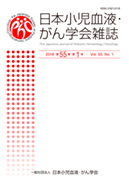Volume 59, Issue 2
Displaying 1-21 of 21 articles from this issue
- |<
- <
- 1
- >
- >|
The 63rd Annual Meeting of the Japanese Society of Pediatric Hematology / Oncology
-
2022Volume 59Issue 2 Pages 101-106
Published: 2022
Released on J-STAGE: July 09, 2022
Download PDF (3344K)
-
2022Volume 59Issue 2 Pages 107-113
Published: 2022
Released on J-STAGE: July 09, 2022
Download PDF (12946K) -
2022Volume 59Issue 2 Pages 114-117
Published: 2022
Released on J-STAGE: July 09, 2022
Download PDF (686K)
-
2022Volume 59Issue 2 Pages 118-123
Published: 2022
Released on J-STAGE: July 09, 2022
Download PDF (1230K) -
2022Volume 59Issue 2 Pages 124-128
Published: 2022
Released on J-STAGE: July 09, 2022
Download PDF (3291K) -
2022Volume 59Issue 2 Pages 129-134
Published: 2022
Released on J-STAGE: July 09, 2022
Download PDF (928K)
-
2022Volume 59Issue 2 Pages 135-139
Published: 2022
Released on J-STAGE: July 09, 2022
Download PDF (864K)
-
2022Volume 59Issue 2 Pages 140-144
Published: 2022
Released on J-STAGE: July 09, 2022
Download PDF (3066K)
-
2022Volume 59Issue 2 Pages 145-150
Published: 2022
Released on J-STAGE: July 09, 2022
Download PDF (842K)
Review Article
-
2022Volume 59Issue 2 Pages 151-162
Published: 2022
Released on J-STAGE: July 09, 2022
Download PDF (1728K)
Original Article
-
2022Volume 59Issue 2 Pages 163-166
Published: 2022
Released on J-STAGE: July 09, 2022
Download PDF (5543K) -
2022Volume 59Issue 2 Pages 167-174
Published: 2022
Released on J-STAGE: July 09, 2022
Download PDF (1195K)
Case Report
-
2022Volume 59Issue 2 Pages 175-178
Published: 2022
Released on J-STAGE: July 09, 2022
Download PDF (5303K) -
2022Volume 59Issue 2 Pages 179-183
Published: 2022
Released on J-STAGE: July 09, 2022
Download PDF (4037K) -
2022Volume 59Issue 2 Pages 184-187
Published: 2022
Released on J-STAGE: July 09, 2022
Download PDF (3152K) -
2022Volume 59Issue 2 Pages 188-191
Published: 2022
Released on J-STAGE: July 09, 2022
Download PDF (781K) -
2022Volume 59Issue 2 Pages 192-196
Published: 2022
Released on J-STAGE: July 09, 2022
Download PDF (5052K) -
2022Volume 59Issue 2 Pages 197-201
Published: 2022
Released on J-STAGE: July 09, 2022
Download PDF (1940K)
Report
-
2022Volume 59Issue 2 Pages 202-204
Published: 2022
Released on J-STAGE: July 09, 2022
Download PDF (773K) -
2022Volume 59Issue 2 Pages 205-208
Published: 2022
Released on J-STAGE: July 09, 2022
Download PDF (817K) -
2022Volume 59Issue 2 Pages 209-213
Published: 2022
Released on J-STAGE: July 09, 2022
Download PDF (5663K)
- |<
- <
- 1
- >
- >|
